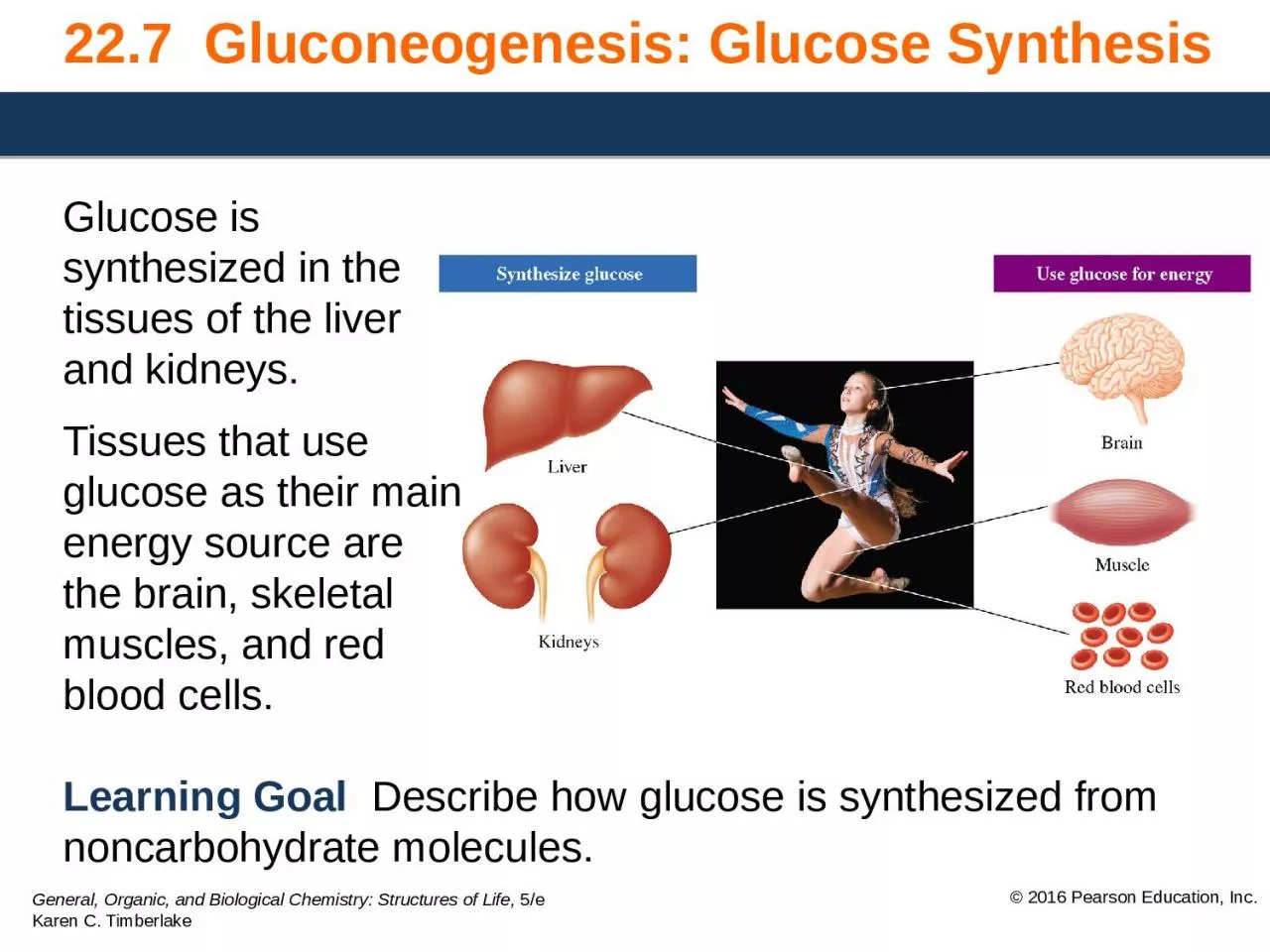

Learning Goal Describe how glucose is synthesized from noncarbohydrate molecules Glucose is synthesized in the tissues of the liver and kidneys Tissues that use glucose as their main energy source are the brain skeletal muscles and red blood cells ID: 1030292
Download Presentation The PPT/PDF document "22.7 Gluconeogenesis: Glucose Synthesis" is the property of its rightful owner. Permission is granted to download and print the materials on this web site for personal, non-commercial use only, and to display it on your personal computer provided you do not modify the materials and that you retain all copyright notices contained in the materials. By downloading content from our website, you accept the terms of this agreement.
1. 22.7 Gluconeogenesis: Glucose SynthesisLearning Goal Describe how glucose is synthesized from noncarbohydrate molecules.Glucose is synthesized in the tissues of the liver and kidneys. Tissues that use glucose as their main energy source are the brain, skeletal muscles, and red blood cells.
2. Utilization of GlucoseGlucose is the primary energy source for the brain, skeletal muscle, and red blood cells. Glucose deficiency can impair the brain and nervous system.If our glycogen stores are depleted, liver cells synthesize glucose by gluconeogenesis.glucose is synthesized in the cytosol of the liver cells, and some is synthesized in the kidneys.
3. Glycogen Glycogen can supply us with about one day’s requirement of glucose.is made from glucose, most of which is synthesized in the cytosol of liver cells.To begin gluconeogenesis, carbon atoms from noncarbohydrate food sources are converted to pyruvate.
4. Pyruvate to PhosphoenolpyruvateTo start the synthesis of glucose from pyruvate, two catalyzed reactions are needed to replace reaction 10 in glycolysis. pyruvate carboxylase uses the energy of ATP hydrolysis to catalyze the addition of CO2 to pyruvate and produce oxaloacetate.phosphoenolpyruvate carboxykinase converts oxaloacetate to phosphoenolpyruvate.phosphoenolpyruvate molecules now use enzymes to form fructose-1,6-bisphosphate.
5. Pyruvate to Phosphoenolpyruvate
6. Fructose-1,6-Bisphosphate to Fructose-6-PhosphateThe second irreversible reaction in glycolysis is bypassed when fructose-1,6-bisphosphatase cleaves a phosphate group from fructose-1,6-bisphosphate. The product fructose-6-phosphate undergoes the reversible reaction 2 of glycolysis to yield glucose-6-phosphate.
7. Glucose-6-Phosphate to GlucoseIn the final irreversible reaction, the phosphate group of glucose-6-phosphate is hydrolyzed by a different enzyme, glucose-6-phosphatase, to form glucose.
8. Glycolysis and Gluconeogenesis
9. Energy Cost of GluconeogenesisThe pathway consists of seven reversible reactions of glycolysis and four new reactions that replace the three irreversible reactions.Overall, glucose synthesis requires 4 ATPs, 2 GTPs, and 2 NADHs.
10. Lactate and the Cori CycleThe Cori cycleis the flow of lactate and glucose between the muscles and the liver.occurs when anaerobic conditions occur in active muscle, and glycolysis produces lactate.operates when lactate moves through the blood stream to the liver, where it is oxidized back to pyruvate.converts pyruvate to glucose, which is carried back to the muscles.
11. Lactate and the Cori Cycle
12. Regulation of GluconeogenesisGluconeogenesis isnot utilized when the diet is high in carbohydrates.very active when the diet is low in carbohydrates.When conditions in a cell favor glycolysis, there is no synthesis of glucose. When the cell requires the synthesis of glucose, glycolysis is turned off.
13. Regulation, Glycolysis, and Gluconeogenesis
14. Metabolic Reactions of GlucoseGlycolysis involves the breakdown of glucose, and gluconeogenesis involves the synthesis of glucose from noncarbohydrates. The pentose phosphate pathway converts glucose to ribose and provides NADPH. Glycogenolysis degrades glycogen to glucose whereas glycogenesis produces glycogen from glucose.
15. Study CheckIdentify each process.1) glycolysis 2) glycogenesis3) glycogenolysis 4) gluconeogenesisthe synthesis of glucose from noncarbohydrates the breakdown of glycogen into glucose the oxidation of glucose to two pyruvate the synthesis of glycogen from glucose
16. SolutionIdentify each process.1) glycolysis 2) glycogenesis3) glycogenolysis 4) gluconeogenesisthe synthesis of glucose from noncarbohydrates 4) gluconeogenesisthe breakdown of glycogen into glucose 3) glycogenolysisthe oxidation of glucose to two pyruvate 1) glycolysisthe synthesis of glycogen from glucose 2) glycogenesis
17. Concept Map